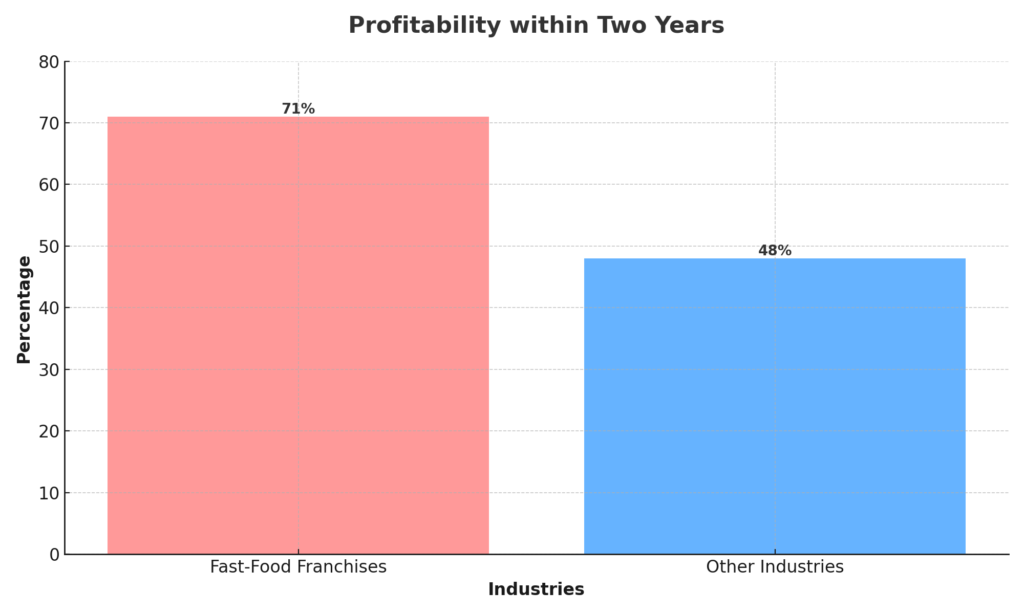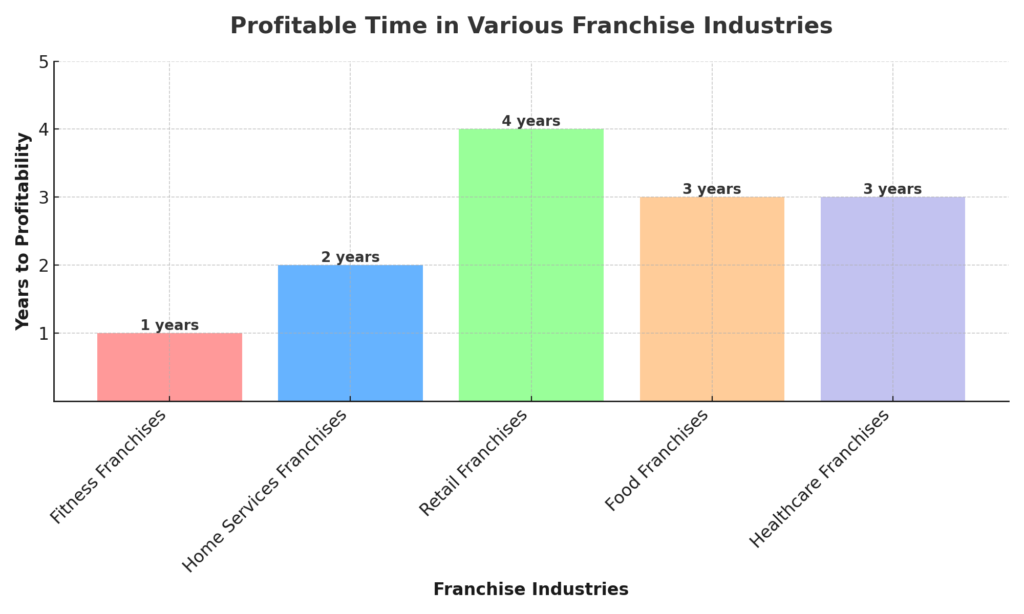Â
Starting a franchise can be an exciting and promising venture, but a question that looms large for most aspiring franchisees is: How long does it take to become profitable in a franchise business? While the answer varies depending on several factors, understanding these variables will give you a clearer picture of what to expect on your journey toward profitability. In this article, we’ll explore how long it typically takes, what impacts the timeline, and provide real-world statistics and references to help you make informed decisions.
The Typical Timeline: What to Expect
Â
Â
In general, most franchise businesses take anywhere from one to three years to become profitable. This is an average figure, and there are plenty of exceptions. Some franchises may see profits as early as the first few months, while others might take longer than three years. A few critical factors that influence this timeline include initial costs, operational efficiency, market demand, and how well you execute your business plan.
-
Initial Costs and Investment Size
The initial investment in a franchise is one of the most significant factors influencing when you’ll reach profitability. Franchises require upfront investments for things like:
- Franchise fees
- Equipment
- Real estate (leasing or buying a location)
- Inventory
- Marketing and branding
For example, franchise fees alone can range from $10,000 to $50,000 depending on the brand, while the total investment might be anywhere between $100,000 and $500,000 (or more, in the case of larger franchises like McDonald’s). The more you invest upfront, the longer it may take to recoup your costs and see positive cash flow.
Example: McDonald’s Initial Investment and Payback Time
Â
A McDonald’s franchise requires an initial investment of $1.3 million to $2.3 million, and while the brand is well-known for its high earning potential, it typically takes 2 to 4 years to break even.
-
Operating Costs: Ongoing Expenses
Operating costs—such as employee wages, rent, utilities, supplies, and royalties paid to the franchisor—play a major role in determining how quickly you become profitable. For example, most franchises require royalty fees that range from 5% to 10% of your gross sales.
The lower your operating costs relative to your revenue, the faster you’ll hit profitability. Conversely, if your operational costs are higher than expected, it can extend the time it takes to reach profitability.
-
Market Demand: Location and Industry Matter
The type of franchise you invest in and its market demand are two of the most decisive factors in how quickly you can start generating a profit. If you’re operating in a high-demand industry (e.g., food service, fitness, or healthcare) and in a prime location, you’re more likely to see a faster return on investment.
According to Franchise Business Review, industries like fast food and quick-service restaurants (QSRs) are typically quicker to become profitable because of their high volume of sales. However, these franchises often come with higher upfront costs.
Example: Quick-Service Restaurants (QSRs)
A study by Franchise Grade showed that 71% of fast-food franchises become profitable within two years, compared to just 48% of franchises in other industries.

-
Execution: How Well You Run the Business
One of the most crucial factors in reaching profitability is how well the franchise is managed. Even the best franchise system can struggle if you don’t execute the business model effectively. Managing expenses, optimizing marketing strategies, and delivering excellent customer service are all important.
Good franchisors provide support, but ultimately, how you manage your daily operations can make or break your profitability timeline. Franchisors typically look for franchisees who have a strong work ethic and are ready to invest time in learning the business, so they can achieve long-term success.
-
Franchise Support and Training
One of the biggest advantages of franchising is that you aren’t going into business alone. Many franchises offer extensive training programs and ongoing support to help their franchisees succeed. Well-established franchises often have better resources and operational systems, which means you can potentially reach profitability faster. According to the International Franchise Association (IFA), 94% of franchisees say they are satisfied with the training and support provided by their franchisors, which can help shorten the time to profitability.
-
Economic and External Factors
Market conditions, competition, and the overall economic environment can all affect how long it takes a franchise to become profitable. During economic downturns or periods of low consumer spending, it may take longer to hit profitability, even if you’re doing everything right.
During the COVID-19 pandemic, for example, many franchise businesses faced unprecedented challenges. A 2020 survey by FranNet found that 48% of franchisees saw a slowdown in profitability timelines, with many taking extra months or even years to recover. However, resilient industries like delivery services, home improvement, and healthcare franchises saw an increase in demand and profitability during this period.
Here are some extra sources that can offer valuable insights into how franchises operate in Toronto. By utilizing the information acquired from these sources, you can confidently begin your journey toward becoming a prosperous franchise owner. These resources provide various viewpoints and can assist you in navigating the realm of franchising with assurance and proficiency.
- No Restaurant Experience? No Problem! Why Franchises Make Food Business Easy
- Foodie Frenzy or Franchise Fortune? Why Food Franchises are Booming (and How You Can Join!)
- Top Questions to Ask Before Purchasing a Food Franchise
- A Guide to Understanding the Franchise Disclosure Document
What Does Profitability Look Like?
Profitability isn’t just about revenue exceeding costs; it’s about sustainable cash flow. Once a business consistently earns more than it spends on a monthly basis, it’s considered profitable. However, “profit” can mean different things to different people. Are you considering net profits (after all expenses, including taxes and royalties) or gross profits (before certain deductions)?
Key Benchmarks on the Road to Profitability
Â
Achieving profitability can be divided into key benchmarks:
- Break-even Point: This is when your revenue equals your total operating costs, including both fixed and variable expenses. This is the first sign that profitability is within reach.
- Positive Cash Flow: After reaching the break-even point, you start generating more cash than you’re spending. Positive cash flow is a sign that you are covering operating costs, debt repayments, and royalties.
- Net Profit Margin: Once you’re operating with a positive cash flow, you can begin to measure how much money is left after all costs are paid. The average franchise sees a net profit margin of around 5% to 10%.
Â
Â
Case Studies: Time to Profitability in Popular Franchise Industries
Â
Â
-
Fitness Franchises
Fitness franchises like Anytime Fitness or OrangeTheory Fitness are often touted for their low startup costs and high demand, especially as the wellness trend continues to grow. However, the timeline to profitability varies greatly based on location and membership growth. Many fitness franchises see profits within 6 months to 1 year if they can quickly build a strong customer base. According to a report from IBISWorld, fitness franchises can reach profitability faster than other service-based businesses, with 51% of franchisees reaching profitability within the first year.
-
Home Services Franchises
Home services, such as cleaning and maintenance, saw a surge in demand, especially during the pandemic. Companies like MaidPro and Handyman Connection generally take 1 to 2 years to become profitable, with lower upfront investments than food or retail franchises. FranData shows that 60% of home services franchises break even within the first year, thanks to their essential nature and relatively low overhead costs.
-
Retail Franchises
Retail franchises tend to take longer to become profitable due to higher operational costs, such as inventory, staffing, and real estate. According to a survey by Franchise Business Review, most retail franchises take 2 to 4 years to become profitable, with 42% of franchisees stating they reached profitability by the end of their second year.

Can You Speed Up the Process?
There are a few strategies you can implement to potentially speed up the time it takes to reach profitability:
- Choose a Franchise with a Strong Brand Presence: A well-known brand has built-in customer trust, reducing the time you need to spend on marketing.
- Negotiate Better Lease Terms: Real estate costs can be a significant drain on profitability, so finding a favorable lease agreement can help you save on one of your largest operating expenses.
- Focus on Marketing and Local Engagement: Leveraging local SEO, social media marketing, and community outreach can help build a customer base more quickly, leading to faster profitability.
- Keep a Close Eye on Costs: While revenue is important, so is managing your expenses. Keeping operating costs low while maintaining quality is key to reaching profitability faster.
Â
Â
Conclusion: What’s the Bottom Line?
Â
The road to profitability in a franchise business typically takes anywhere from one to three years, but the timeline varies based on factors such as industry, investment size, location, and how well you run the business. Industries with high demand and lower startup costs, like fitness and home services, tend to see profits faster, while retail and food franchises may take longer due to higher overhead costs.
As a prospective franchise owner, it’s essential to research your chosen industry and brand, manage your expenses carefully, and use all the resources your franchisor offers to help you succeed. While it may take time, a well-run franchise has the potential to become not only profitable but a thriving, long-term business.
The final reflections on the PHO franchise opportunity in Toronto
Operating a pho franchise in Toronto presents a lucrative and fulfilling opportunity. With its multicultural population, robust economy, and vibrant food scene, the city provides an excellent setting for success. However, conducting thorough research to find the right franchise and developing effective marketing strategies are key to standing out in this competitive market.
To succeed, it’s important to seek expert guidance, connect with experienced franchise owners, and keep up with evolving customer preferences. By capitalizing on Toronto’s growing demand for pho, you can build a thriving business and position yourself for long-term success in this dynamic market.
Explore the exciting opportunities of owning a pho franchise in Toronto! Our franchise has experienced substantial growth, proving the strength of this business model. Get in touch with the Toronto PHO franchise team today to discover the full potential of this venture. We offer competitive franchise fees and strong support to help ensure your profitability in this flourishing market.
To find us, simply search for “pho near me” and visit our locations in Toronto, North York, Woodbridge, and Hamilton. These locations were strategically chosen for their accessibility to public transportation and ample parking, making it easy for our customers to enjoy our offerings.
